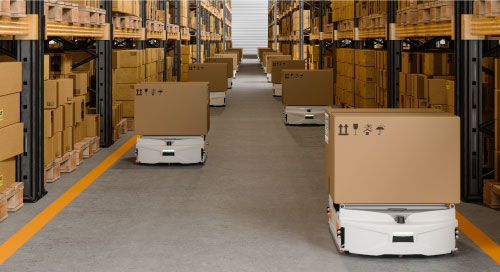Fill form to unlock content
Error - something went wrong!
Your content is just a step away. Please submit below.
Thank you!
No-Code Software Scales Vision AI Deployments at the Edge

Reinventing the wheel every time you embark on a new project is frustrating; your enthusiasm quickly begins to wane. Unfortunately, this problem plagues development of vision AI solutions for the edge, leading to stop-and-go approaches and sporadic implementations of the technology.
Dimitris Kastaniotis, Head of Product at Irida Labs, a computer vision and AI solutions software company, says one-off successes might be proof of operational efficiencies that edge vision AI can deliver, but the technology has not scaled well for mass deployment.
Irida Labs has a solution to this problem. The company’s PerCV.ai software helps edge vision AI deployments scale by keeping operational costs low and creating and using viable data. It also delivers infrastructure generic enough to work with data from the field and recalibrate on actual installation conditions.
Before AI models can hit the ground running, they need information. PerCV.ai has a data engine that attends to pre- and post-processing of data and creates, annotates, and manages it. The engine works with a cocktail of proprietary and synthetic data so projects can hit the ground running, instead of waiting months upon months to get one-off points from the field.
For further ease of deployment, PerCV.ai is a no-code solution that can be pushed directly inside an edge device. A central platform makes changing the functionality or recalibrating edge cameras a breeze. Equally important, hosting cameras and analyzing data at the edge avoids steep cloud computing costs. Using PerCV.ai helps validate business use cases quickly so companies can then deploy the projects at needed scale. And Intel technology, including the Intel® Movidius™ Myriad™ VPU, has speeded up prototyping and product development, Kastaniotis says.
Uses of edge vision #AI and PerCV.ai are practically limitless, including in #Industry40, the #manufacturing industry’s version of #DigitalTransformation. @IRIDALabs via @insightdottech
Implementations of Vision AI
Uses of edge vision AI and PerCV.ai are practically limitless, including in Industry 4.0, the manufacturing industry’s version of digital transformation.
While Industry 4.0 is a multi-pronged term applicable to a variety of operations and subsectors, Irida Labs works to implement its driving principle of AI-based automation in logistics and warehouse management. Among the primary challenges that warehousing and logistics face is finding exactly what is where at any given time. Loading operations are not automated, either. “Many operations in the warehouse could benefit from the installation of cameras and edge vision AI,” Kastaniotis says.
Take, for example, an automated guided vehicle (AGV) that loops around a warehouse picking up goods. Too often the AGV goes on a wasted errand, looking for products that are not on the shelves, decreasing productivity. PerCV.ai solves this problem through cameras installed on shelves taking accurate product inventory and integrating this information into PLC servers on the AGV. This way the AGV goes hunting only if it is told the product is actually in the location.
Such a solution is just one building block of many for an autonomous warehouse or factory, Kastaniotis says.
The PerCV.ai solution has also helped companies enforce access zones in warehouses through identification of uniforms, which becomes especially important in large-scale facilities that employ a mix of in-house workers and contractors. Using cameras and real-time alerts, warehouse management can tell when workers are trying to access areas they should not.
These two use cases are just a sample of the many ways in which the Irida platform can deliver edge vision AI. Monitoring liquid flow is another implementation. In all instances, “you have the same backbone and the same infrastructure, but real-time processing needs are vastly different, so we just approach them in the same structured way through the same platform infrastructure,” Kastaniotis points out.
Irida Labs strictly adheres to privacy laws and does not work on face recognition. Personal identifying information is not stored at the edge but used only for analytics. Irida also does not use training data from one company for another’s AI models.
Working with Systems Integrators
While Irida might help speed product development, it does not deliver complete bespoke solutions.
Instead, it helps ensure viability of approaches so customers can complete that last mile. Systems integrators are especially effective at picking up the baton and customizing solutions for their clients. SIs use PerCV.ai to test-drive the viability of projects. The software allows SIs to calibrate the solution for field-specific data and push it out directly with minimal- to no-code processes.
“SIs need one more weapon in their arsenal to start generating more revenue for themselves and for the rest of the parties involved by providing better service,” Kastaniotis says. And the sales-based model for PerCV.ai delivers just that: a quick and scalable way to generate new revenue streams with edge vision AI projects.
While leveraging edge vision AI for more sales, it also helps to understand the landscape and know the technology’s limitations. First, companies need to understand what data sets they have so they can fill any gaps with synthetic data. The technology also has performance constraints so companies must consider tradeoffs between accuracy and power consumption. Finally, using vision to understand your environment takes a bit of work. “You need to have an understanding from beginning to end of what you’re trying to do,” Kastaniotis says. “You need infrastructure that can connect these dots. If not, it’s very difficult to reach a solution and to simplify your life.”
We have just begun to scratch the surface for edge vision AI, so Kastaniotis is excited about its future and predicts the number of tasks that can be automated is going to increase significantly. Being able to detect falls in patients or drowsiness while driving are two very tangible implementations.
And edge vision AI, combined with no-code software, is making the future of autonomous operations close at hand.
Edited by Georganne Benesch, Editorial Director for insight.tech.